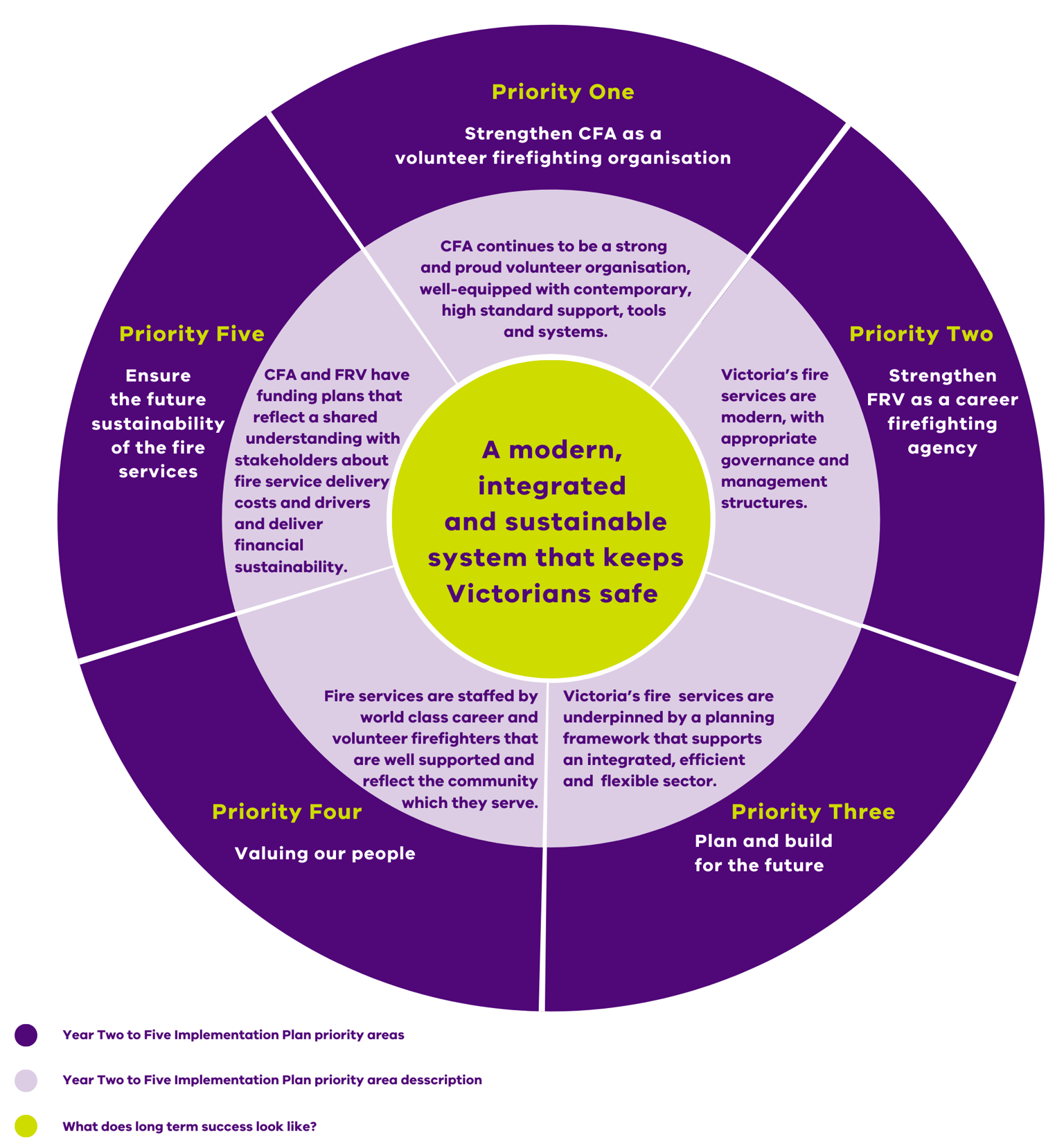In 2017, the Victorian Government released the Fire Services Statement, setting out the vision of a modern fire services model for a safer Victoria. The Victorian Government enshrined in legislation a requirement for the Minister for Emergency Services (the Minister) to prepare an Implementation Plan to enact this vision. The Implementation Plan guides a ten-year Fire Services Reform program to modernise the fire services to keep Victorians safe.
This FY 2022-23 annual report provides FSIM’s assessment of progress against the Year Two to Five Plan. The annual report covers the period from 1 July 2022 to 30 June 2023 and delivers on the requirement, under section 131(1) of the FRV Act, for FSIM to prepare an annual report on its findings about the performance of FSIM’s functions.
Fire Services Reform
On 1 July 2020, Victoria’s new fire services model was implemented through the establishment of FRV, which brought together the former Metropolitan Fire Brigade (MFB) and CFA career firefighters and restored CFA to a community-based, volunteer firefighting organisation.
The reform resulted in designated staff and asset transfers from CFA to FRV. The FSIM’s Annual Report 2021/22 outlined details of these transfers, including associated property, rights, liabilities, and obligations. Further to this restructure and to ensure CFA could continue providing appropriate operational leadership and support to volunteers, CFA and FRV entered into a Secondment Agreement on 31 October 2020.
This Secondment Agreement establishes arrangements for the secondment of FRV Assistant Chief Fire Officers (ACFOs), Commanders, instructors, Practical Areas for Drills (PAD) Supervisors and PAD Operators to CFA to provide operational and volunteer support. The FRV Operational EA details the terms and conditions governing FRV staff, and the Secondment Agreement sets out that when FRV staff are seconded to CFA, their work is under the command and control of the CO, CFA.[2]
Fire Services Reform Implementation Plans
The Fire Services Statement, together with the Year One Fire Services Reform Implementation Plan and Year Two to Five Plan provide five priority areas to guide a ten-year reform program to modernise the fire services that keep Victorians safe. Each action in the Year Two to Five Plan, aligns to one of five priority areas.
Under section 130 of the FRV Act, the Minister is required to prepare an Implementation Plan within 60 days of the day the FRV Act commenced and must include actions relating to:
- the adoption of procedures by CFA and FRV to enable them to have regard to the priorities set out in the Fire Services Statement in carrying out their functions
- the financial sustainability of CFA and FRV, including ensuring that volunteer brigades are not adversely affected by the fire services reforms
- improvements in the ability of CFA, FRV and other emergency agencies to work effectively across organisational boundaries
- the provision of operational and management support by FRV to CFA, and the effectiveness of this support in enabling CFA to meet the objectives set out in section 2 of the Country Fire Authority Act 1958[3]
- improvements in staff training in relation to CFA and FRV
- development of an initial and a long-term funding plan to determine the financial requirements of CFA and FRV.
In October 2020, the Minister tabled the Year One Fire Services Reform Implementation Plan in Parliament. The Year One Fire Services Reform Implementation Plan included actions for CFA, FRV and government to establish modern, efficient, and flexible systems and arrangements and to design the necessary methodologies and approaches for agencies to perform their functions.
In November 2021, the Minister tabled the Year Two to Five Plan in Parliament. This plan consists of actions that were reframed and rolled over from the Year One Fire Services Reform Implementation Plan and new actions that reflect organisational reform priorities and built on achievements from the first year of reform.
In May 2023, the Minister tabled the updated Year Two to Five Plan in Parliament, setting out new completion dates for 19 actions and some minor wording changes.[4]
For each Implementation Plan iteration, actions and associated amendments were recommended by the respective action leads – CFA, DJCS and FRV – and approved by the Minister. Agency-defined deliverables guide delivery of actions. CFA, DJCS and FRV report quarterly to the Minister on the status of Year Two to Five Plan action deliverables, with quarterly reporting coordinated by DJCS. When agencies determine that an action has been completed, CFA, DJCS and FRV follow a formal process to acquit actions to the Minister.
The Year Two to Five Plan outlined 41 actions across five priority areas to be delivered across four years of a 10-year reform. It provided success statements at year five and outlined actions to operationalise and embed reform commitments.
Figure 1 outlines the linkages between the Year Two to Five Plan priorities and Fire Services Statement outcomes.
Footnotes
[2] CFA/FRV Secondment Agreement, s7(a): The CO, CFA has the order and control of the work of all Secondees who are made available to CFA under this Agreement. The Parties agree that all Secondees will implement command and control arrangements at the direction of the CO, CFA.
[3] Country Fire Authority Act 1958 s2: Objectives relating to interaction between fire services agencies.
[4] The May 2023 updated Year Two to Five Plan include new action completion dates for 1.5, 2.4, 3.3, 3.7, 3.8, 3.9, 3.10, 3.11, 4.1, 4.2, 4.4, 4.6, 4.7, 5.1, 5.2, 5.3, 5.4, 5.7 and 5.8. Details relating to initial and updated completion dates are included in action progress summaries (section six of this report).
Updated
